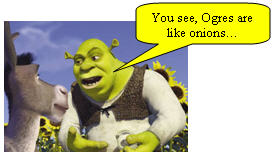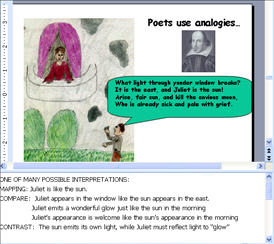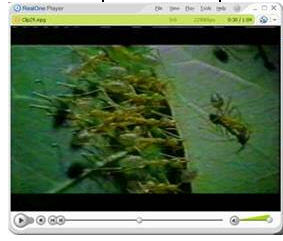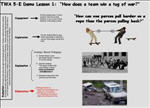Video Clip #1:
Analogies in TV and Movies
 This 3-minute video is meant as an engagement to use before the first PowerPoint. It consists of a series of 8 short clips which illustrate analogy use in various contexts. Students are asked to view the clips and determine what they all have in common and they should quickly realize that each clip illustrates a use of comparison between two dissimilar concepts. The 8 video clips are taken from a variety of familiar television shows and movies to illustrate how analogies are commonly used. In the first example, Shrek explains how ogres are like onions. Then television actor Tom Selleck uses the analogy that an actor going out on stage is like a cartoon coyote who has run off a cliff. In the 3rd clip, a television lawyer from “Law and Order” uses an analogy as a basis to create an argument to persuade a judge. The 4th clip shows Jim Carey in the movie “Dumb and Dumber” using an analogy to describe what Aspen is like. In the 5th clip, a biologist uses an analogy to explain tiger behavior. In the 6th clip, an analogy is used to explain the difficulties encountered in developing an antiballistic missile defense system. In the 7th clip, a popular musician uses an analogy to describe his experience performing. And in the final clip, Millhouse uses an analogy to explain Principal Skinner’s relationship with Miss Krabapple to Bart Simpson.
This 3-minute video is meant as an engagement to use before the first PowerPoint. It consists of a series of 8 short clips which illustrate analogy use in various contexts. Students are asked to view the clips and determine what they all have in common and they should quickly realize that each clip illustrates a use of comparison between two dissimilar concepts. The 8 video clips are taken from a variety of familiar television shows and movies to illustrate how analogies are commonly used. In the first example, Shrek explains how ogres are like onions. Then television actor Tom Selleck uses the analogy that an actor going out on stage is like a cartoon coyote who has run off a cliff. In the 3rd clip, a television lawyer from “Law and Order” uses an analogy as a basis to create an argument to persuade a judge. The 4th clip shows Jim Carey in the movie “Dumb and Dumber” using an analogy to describe what Aspen is like. In the 5th clip, a biologist uses an analogy to explain tiger behavior. In the 6th clip, an analogy is used to explain the difficulties encountered in developing an antiballistic missile defense system. In the 7th clip, a popular musician uses an analogy to describe his experience performing. And in the final clip, Millhouse uses an analogy to explain Principal Skinner’s relationship with Miss Krabapple to Bart Simpson. After students figure out that all the video clips illustrate a use of an analogy, the instructor leads a brief discussion about the function of the analogies in each example. It is interesting how easy it is to find great examples of analogy use in virtually ANY movie, TV show, or cartoon. I like to use the analogy that using analogies is like using our cornea – we are usually unaware that either exists, but we rely heavily on each.


 This presentation was designed to illustrate numerous examples of how scientists have routinely used analogies to help understand new concepts and make discoveries. In addition to providing numerous examples, the presentation also focuses on how scientists use
This presentation was designed to illustrate numerous examples of how scientists have routinely used analogies to help understand new concepts and make discoveries. In addition to providing numerous examples, the presentation also focuses on how scientists use  This final presentation builds on the pricinples developed in the first two presentations and final provides specific examples and guidlines for using analogies in teaching. Three techniques in using analogies are developed: Using analogies when introducing new topics, specific analogy based lesson planning strategies, and helping students generate critical questions during student centered exploration.
This final presentation builds on the pricinples developed in the first two presentations and final provides specific examples and guidlines for using analogies in teaching. Three techniques in using analogies are developed: Using analogies when introducing new topics, specific analogy based lesson planning strategies, and helping students generate critical questions during student centered exploration.